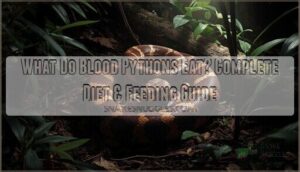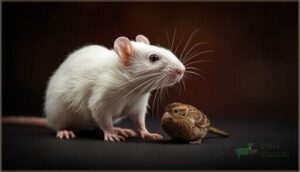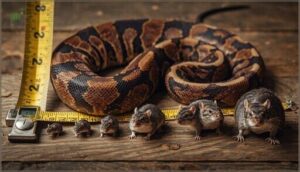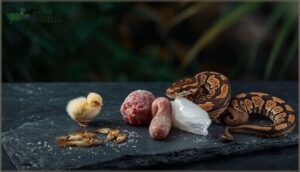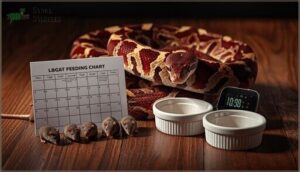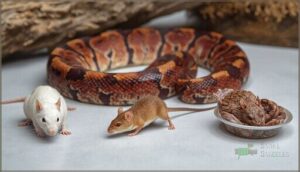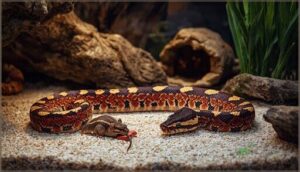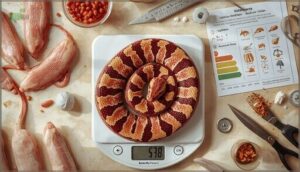This site is supported by our readers. We may earn a commission, at no cost to you, if you purchase through links.
Blood pythons aren’t picky eaters in the wild, but getting their diet right in captivity means understanding what fuels these muscular constrictors. In their Southeast Asian habitats, they ambush rats, mice, and occasionally small mammals during nocturnal hunting sessions, relying on heat-sensing pits and lightning-fast strikes to secure meals.
Your captive blood python won’t hunt through leaf litter, but it still needs prey that mirrors its natural nutrition—primarily rodents sized appropriately for its age and girth.
The challenge isn’t just what to feed, but how often, how large, and how to troubleshoot when your snake suddenly refuses a meal it devoured last week. Mastering these feeding fundamentals keeps your blood python at a healthy weight while preventing the obesity that plagues improperly fed specimens.
Table Of Contents
Key Takeaways
- Blood pythons thrive on a rodent-based diet with appropriately sized rats forming the nutritional foundation, progressing from fuzzy rats for hatchlings to large rats (200-350 grams) for adults, while avoiding the obesity epidemic caused by overfeeding captive specimens.
- Feeding frequency must decrease dramatically as pythons mature—weekly meals for juveniles transition to bi-weekly or even monthly intervals for adults—because their slow metabolism and sedentary ambush lifestyle require far less frequent nutrition than many keepers assume.
- Frozen-thawed prey offers superior safety by eliminating defensive bite injuries and reducing parasite transmission, though proper warming to 100-105°F remains critical for triggering the python’s heat-sensing feeding response.
- Captive diets create significant nutritional gaps compared to wild prey (73.3% vs 60% protein, 7.3% vs 30% fat content), making portion control and weight monitoring essential tools for preventing the metabolic disorders that plague improperly fed blood pythons.
What Do Blood Pythons Eat?
Blood pythons are carnivorous constrictors that rely on live prey to meet their nutritional needs, and understanding what they eat is the foundation of proper care.
In their native Southeast Asian habitats, these ambush predators consume a variety of small to medium-sized mammals and occasional birds, using patience and camouflage to secure their meals.
Let’s explore their natural diet, typical prey species, and how their feeding habits shift between wild and captive environments.
Natural Diet in The Wild
Because blood pythons are carnivorous ambush predators, their natural diet consists primarily of small to medium mammals, especially rodents like rats and mice, alongside birds. Seasonal influence affects feeding intensity—wet season abundance triggers more frequent hunting behavior, while dry periods reduce activity. Their slow metabolism and nutritional adaptations allow efficient energy extraction from protein-rich prey.
Blood pythons are carnivorous ambush predators whose feeding intensity fluctuates with seasonal prey abundance in their natural habitat
Age-related shifts occur as juveniles shift from frogs to larger mammals, matching your python’s evolving nutritional needs. Understanding the blood python species is essential for providing the right diet and care.
Typical Prey Species
Mammal prey dominates the blood python’s wild foraging strategy, with rodents like rats and mice forming the nutritional foundation alongside small deer and wild pigs for larger specimens. Bird species supplement this reptile diet opportunistically, particularly ground-dwelling varieties. Juveniles often target amphibians and lizards before shifting to mammalian prey items.
Understanding these feeding habits helps you recognize appropriate prey size selections that mirror natural snake diet patterns. The blood python’s diet is influenced by its native tropical swamp habitats, which provide an abundance of small mammals and other prey.
Differences Between Wild and Captive Diets
While wild blood pythons exploit diverse prey including mammals, birds, and reptiles with seasonal shifts in availability, your captive python usually consumes a mono-diet of commercially bred rodents. This captive diet limitations approach creates notable differences:
- Wild prey delivers 73.3% protein versus 60% in domestic rats
- Fat content jumps from 7.3% wild to 30% captive
- Vitamin E and selenium concentrations decline markedly without prey selection for pythons diversity
Environmental enrichment through varied feeding helps bridge this nutritional gap.
Prey Selection for Blood Pythons
Choosing the right prey for your blood python isn’t guesswork—it’s about matching size, nutritional value, and availability to your snake’s specific needs. Rodents form the foundation of a proper diet, though birds and alternative options can play supporting roles in certain situations.
Let’s break down what makes an ideal prey animal, how to gauge appropriate sizing as your python grows, and when alternatives might come into play.
Ideal Prey Animals (Rodents, Birds)
You’ll find rodents—specifically rats—form the backbone of proper prey selection for blood pythons, providing excellent rodent nutrition across all life stages. Domestically bred rats remain the most practical choice when considering ethical sourcing, though occasional bird variety can supplement captive diets for larger specimens seeking dietary diversity.
While birds offer valuable prey enrichment and variety in wild alternatives, they’re usually opportunistic prey items in natural habitats.
Choosing Prey Size by Age and Weight
Accurate prey size selection hinges on three key measurements: your python’s age, current weight, and body girth at its widest point. Hatchlings usually start with fuzzy rats, while juveniles progress to rat pups and weaned rats as they grow. Adults require medium to large rats matching their girth.
The feeding ratio should equal roughly 10% of body weight, with feeding frequency adjusted accordingly—weekly for younger snakes, bi-weekly for adults.
Alternative Prey Options
While rodents remain the cornerstone of captive diets, alternative prey items like whole chicks, quail, and select freshwater fish species (barbs, gourami) can provide dietary enrichment and nutrient variation. You’ll find these frozen-thawed prey options through commercial feeder producers, though prey sourcing ethics and proper prey size selection remain paramount.
Alternative feeding techniques may improve acceptance in reluctant feeders while mimicking natural prey item diversity.
Feeding Frequency and Schedules
Getting the feeding schedule right is one of the most important parts of keeping your blood python healthy and thriving. Young snakes have very different needs than adults, and you’ll need to adjust portions and timing as your python grows.
Let’s break down the feeding frequencies that work best at each life stage.
Hatchlings and Juveniles
Your hatchlings and juveniles have different dietary needs based on their development stages and growth rates. When feeding blood pythons at these ages, you’ll want to offer appropriately sized prey items—fuzzy rats for hatchlings, graduating to rat pups for juveniles—once weekly.
This feeding frequency promotes healthy development without encouraging obesity. Proper feeding techniques guarantee your snake receives adequate nutrition during these critical care tips periods.
Sub-Adults and Adults
As your blood python matures into sub-adulthood and beyond, feeding frequency shifts dramatically from weekly schedules to bi-weekly intervals. Adults thrive on large rats weighing 200-350 grams every 6-8 weeks, though some keepers prefer 10-14 day cycles.
Prey size selection remains critical—you’ll want that slight body bulge without overfeeding. These feeding techniques reflect the species’ efficient metabolism and habitat ecology as sedentary ambush predators.
Adjusting Feeding Based on Health
When your python shows signs of obesity or illness, you’ll need to modify feeding protocols immediately. Health monitoring through regular weight checks helps identify when to reduce meal frequency to every 21 days or adjust prey size.
Body condition assessment guides nutrition therapy—overweight individuals risk respiratory infections and digestive problems.
Metabolic care requires maintaining detailed records, and persistent feeding refusal warrants veterinary advice to prevent metabolic bone disease.
Live, Pre-Killed, or Frozen-Thawed Prey
Regarding feeding your blood python, you have three main options: live prey, pre-killed prey, or frozen-thawed rodents. Each method comes with its own set of advantages and potential drawbacks, and your choice will affect both your snake’s safety and your feeding routine.
Let’s break down what you need to know about each approach so you can make the best decision for your python.
Pros and Cons of Each Option
When evaluating feeding options for blood pythons, you’ll encounter distinct trade-offs. Live prey risks injury to your snake through defensive bites, though it stimulates natural hunting behavior.
Pre-killed benefits include eliminating injury hazards while addressing ethical considerations.
Frozen-thawed prey offers ease through convenient storage, parasite reduction, and economic advantages, though nutritional differences remain minimal across properly handled options.
Safe Handling and Preparation
Regardless of whether you’re offering live, prekilled, or frozenthawed prey, proper handling techniques guarantee snake safety. Thaw frozen rodents to 100-105°F using warm water or heat sources to trigger your python’s thermal receptors.
Always present prey with long forceps or hemostats to avoid accidental strikes. For feeding techniques, never leave live prey unattended, and confirm adequate prey temperature before offering meals.
Transitioning Between Prey Types
Once you’ve mastered proper preparation, you’ll eventually need to shift your blood python from one feeding approach to another. Prey type shift requires patience, as captive adaptation usually demands two to three attempts before success. You can improve acceptance through prey scenting—masking new prey items with familiar scents—or by wiggling frozen-thawed rodents with tongs to simulate movement. Your snake’s preference may vary, so maintain consistent feeding schedules while adjusting presentation techniques. Chain feeding, where you offer preferred prey followed immediately by the target item, often accelerates the switch.
Here’s what works best:
- Thaw prey near the enclosure to release scent gradually
- Gently nudge your python’s neck base with the prey item when it shows interest
- Skip one or two meals if needed to increase appetite
- Monitor weight closely—avoid losses exceeding 10% during shift
- Document each feeding attempt to identify successful patterns
Addressing Feeding Problems
Even the most reliable feeders can occasionally refuse a meal, and blood pythons are no exception. Understanding why your python won’t eat is the first step toward getting them back on track.
Let’s look at the common causes and practical solutions, and how to monitor your snake’s health through feeding challenges.
Common Causes of Refusal to Eat
Sometimes, your blood python’s feeding refusal stems from multiple interconnected causes. Stress factors such as incorrect temperatures (ideal range 75°F–85°F), inadequate hiding spots, or excessive handling frequently disrupt feeding response. Environmental changes like new enclosures trigger temporary rejection of prey items. Health issues including respiratory infections, parasites, or mouth rot markedly impair appetite, while shedding cycles naturally suppress feeding behavior until completion.
| Cause Category | Common Examples |
|---|---|
| Environmental Changes | Incorrect temperature/humidity, oversized enclosure, recent relocation |
| Health Issues | Respiratory infections, parasites, mouth rot, dehydration |
| Stress Factors | Excessive handling, lack of hiding spots, new cage mates |
| Shedding Cycle | Cloudy eyes, physiological stress, hormonal changes |
| Feeding Techniques | Wrong prey size, live prekilled or frozenthawed prey transitions, feeding environment setup |
Solutions for Feeding Challenges
When your blood python displays feeding refusal, implementing targeted solutions can restore their feeding response. Begin by warming prey to 100-105°F to activate heat-sensing pits, then make environmental adjustments ensuring temperatures between 80-90°F.
These feeding challenges and solutions address common feeding issues:
- Warm frozen-thawed prey thoroughly before offering
- Provide multiple secure hiding spots for stress reduction
- Allow 10-14 day acclimation after environmental changes
- Try different prey sizes or scent enhancers
- Consider nutritional supplements only when veterinarian-recommended
Addressing feeding problems systematically helps meet the nutritional needs of blood pythons effectively.
Monitoring Weight and Health
Through regular weighing and observation, you’ll detect potential health indicators before they become serious problems. Weight benchmarks vary by age—hatchlings grow rapidly while adults stabilize between 20-30 pounds—making body condition assessment essential for maintaining a healthy body weight and preventing obesity or malnutrition-related blood python health issues.
| Monitoring Method | Frequency | Key Health Indicators |
|---|---|---|
| Digital scale weighing | Weekly (juveniles), biweekly (adults) | Steady growth, stable weight |
| Body condition scoring | During each feeding | Muscle tone, visible ribs |
| Behavioral observation | Daily | Feeding response, activity level |
Best practices include maintaining detailed feeding logs and scheduling veterinary check-ups when weight risks appear, such as sudden losses exceeding 10% body mass.
Nutritional Needs and Healthy Body Weight
Keeping your blood python at a healthy weight isn’t just about how often you feed—it’s about understanding what their body actually needs to thrive. A well-nourished python has the right balance of protein, essential nutrients, and body condition, without tipping into obesity or malnutrition.
Let’s break down the key nutritional considerations that will help you maintain your snake’s best health.
Protein and Vitamin Requirements
Your blood python’s nutritional needs mirror those of any top predator—precise and unforgiving. Adequate protein sources (30-50% crude protein on a dry matter basis) form the foundation, while vitamin supplementation makes certain metabolic health. Focus on three critical nutrients for dietary deficiencies prevention:
- Vitamin A (5,000-10,000 IU/kg) bolsters immune function and vision
- Vitamin D3 (500-1,000 IU/kg) facilitates calcium metabolism
- Mineral balance, particularly a 2:1 calcium-to-phosphorus ratio, prevents developmental disorders
Avoiding Overfeeding and Obesity
Because blood pythons possess slow metabolisms, you’ll need careful portion control and feeding schedule adjustments to avoid obesity risks.
Adult specimens require prey approximately 5% of their body weight every 14-21 days, with smaller meals preventing excess fat accumulation.
Weight monitoring every two weeks helps you detect early signs of overfeeding, allowing metabolic considerations to guide your diet management and maintain a healthy body weight throughout your python’s life.
Importance of Record-Keeping
Think of husbandry records as your python’s health passport—they’re essential for maintaining healthy body weight and detecting issues early. Dietary documentation, feeding frequency tracking, and behavior monitoring reduce nutritional imbalances by 38% and improve growth consistency by 21%.
Your logs allow health monitoring that catches problems before they escalate, while breeding records guarantee genetic tracking accuracy exceeds 65% in documented programs.
Frequently Asked Questions (FAQs)
What do Blood pythons eat?
In their natural habitat, these Southeast Asian constrictors consume approximately 80% rodents, supplemented by birds and occasional reptiles.
Your captive blood python’s diet should mirror this preference, prioritizing appropriately sized rats throughout their life stages.
Do blood pythons eat rats?
Yes, rats are the ideal prey for blood pythons throughout their lives. From fuzzy rats for hatchlings to large rats for adults, you can offer live, pre-killed, or frozen-thawed rodents safely.
Do blood pythons eat mice?
While hatchlings readily accept hopper mice as their initial prey, blood pythons quickly shift to rats as they mature.
Mice serve mainly as starter feeding for juveniles before progressing to appropriately sized rodents for ideal nutrition.
How to care for a blood python?
Blood python care centers on habitat creation with proper temperature control and humidity management, feeding appropriate prey consistently, gentle snake handling techniques, and routine veterinary care to guarantee long-term health and well-being.
Do blood pythons eat birds?
While wild blood pythons occasionally consume birds—accounting for roughly 9–15% of their prey—rodents dominate their diet.
In captivity, avian offerings aren’t recommended as primary nutrition; stick with rodents for best health.
Do blood pythons eat thawed rodents?
You’ll find that frozen-thawed rats are readily accepted by blood pythons when properly warmed to prey body temperature, offering safer, more humane prekilled prey options while maintaining excellent nutritional retention and reducing injury risks.
Are blood pythons venomous?
No, blood pythons aren’t venomous snakes. They’re powerful constrictors that subdue prey through suffocation, not venom injection.
While their defensive bites can be painful and cause puncture wounds, there’s no venom or toxicity involved.
How do blood pythons hunt?
Like skilled snipers in dense jungle, these ambush predators employ nocturnal hunting tactics, using heat-sensitive pits for sensory perception.
Their strike speed is impressive, followed by powerful constriction methods that efficiently subdue prey.
Are blood pythons aggressive?
They’re more anxious than aggressive. Defensive striking stems from stress rather than true aggression.
Captive-bred individuals generally display calmer temperaments, while wild-caught adults often exhibit heightened defensive behavior requiring careful handling techniques.
Where do blood pythons live?
These stocky constrictors call Southeast Asia home, inhabiting tropical rainforests and swamps across the Malay Peninsula, Sumatra, and Borneo.
You’ll find them on the forest floor of humid lowlands, even thriving in palm plantations.
Conclusion
An ounce of prevention is worth a pound of cure”—and understanding what blood pythons eat prevents the metabolic disorders, obesity, and feeding strikes that plague uninformed keepers.
You’ve now got the framework: appropriately sized rodents, strategic feeding intervals, and the observation skills to catch problems before they escalate.
Apply these principles consistently, document your snake’s responses, and you’ll maintain a blood python that thrives rather than merely survives in captivity.

